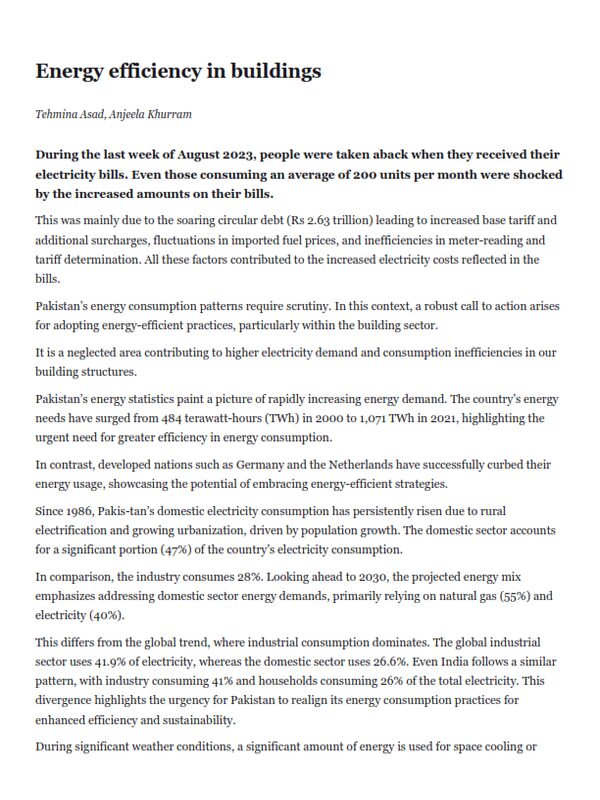Energy efficiency in buildings
During the last week of August 2023, people were taken aback when they received their electricity bills. Even those consuming an average of 200 units per month were shocked by the increased amounts on their bills.
This was mainly due to the soaring circular debt (Rs 2.63 trillion) leading to increased base tariff and additional surcharges, fluctuations in imported fuel prices, and inefficiencies in meter-reading and tariff determination. All these factors contributed to the increased electricity costs reflected in the bills.
Pakistan’s energy consumption patterns require scrutiny. In this context, a robust call to action arises for adopting energy-efficient practices, particularly within the building sector.
It is a neglected area contributing to higher electricity demand and consumption inefficiencies in our building structures.
Pakistan’s energy statistics paint a picture of rapidly increasing energy demand. The country’s energy needs have surged from 484 terawatt-hours (TWh) in 2000 to 1,071 TWh in 2021, highlighting the urgent need for greater efficiency in energy consumption.
In contrast, developed nations such as Germany and the Netherlands have successfully curbed their energy usage, showcasing the potential of embracing energy-efficient strategies.
Since 1986, Pakis-tan’s domestic electricity consumption has persistently risen due to rural electrification and growing urbanization, driven by population growth. The domestic sector accounts for a significant portion (47%) of the country’s electricity consumption.
In comparison, the industry consumes 28%. Looking ahead to 2030, the projected energy mix emphasizes addressing domestic sector energy demands, primarily relying on natural gas (55%) and electricity (40%).
This differs from the global trend, where industrial consumption dominates. The global industrial sector uses 41.9% of electricity, whereas the domestic sector uses 26.6%. Even India follows a similar pattern, with industry consuming 41% and households consuming 26% of the total electricity. This divergence highlights the urgency for Pakistan to realign its energy consumption practices for enhanced efficiency and sustainability.
During significant weather conditions, a significant amount of energy is used for space cooling or heating in different types of buildings, including residential, commercial, and public structures. The Increased energy consumption in these buildings is primarily due to their construction materials and designs.
Numerous buildings have been constructed using thermally conductive materials that lack adequate insulation capacity. Consequently, these buildings become excessively warm during summers and uncomfortably cold during winters. This temperature inefficiency necessitates considerable energy for regulating and controlling the indoor climate.
The energy demand in Pakistan fluctuates significantly between winters (12MW) and summers (32MW), with the high cooling load being the primary contributing factor. Domestic cooling accounts for nearly 37.10% of the total capacity, while commercial cooling contributes to approximately 65% of the total energy demand, resulting in a difference of around 20 KMW. The generation of electricity at high rates to meet this additional demand leads to high tariffs and capacity costs.
By 2025, the peak electricity demand in Pakistan is expected to increase by an additional 4000MW. This gap is anticipated to widen due to various factors, including the growing electricity consumption in the building sector.
The rising demand for new construction in Pakistan provides a significant opportunity to enhance energy efficiency by employing energy-efficient techniques, materials, and practices for better building design. With a yearly growth of 5.3% in construction demand due to rapid urbanization and population increase, urban areas are projected to accommodate over 40 million people by 2023, necessitating new structures and escalating energy requirements.
Enforcing the Energy Conservation Building Code (ECBC) within the construction sector becomes crucial to address this.
Enhancing the efficiency of building envelopes can reduce air conditioning electricity consumption by approximately 20%. One practical approach involves integrating energy-efficient strategies into new construction using sustainable materials, technologies, and innovative design methodologies like Building Information Modeling (BIM).
Embracing and enforcing building codes within Pakistan’s construction landscape offers a promising route toward achieving energy efficiency objectives, especially amid the prevailing energy crisis.
When followed, Energy Conservation Building Codes (ECBCs) can facilitate the design and construction of energy-efficient buildings and minimize energy wastage. Anticipating a 5.3% annual rise in new construction, Pakistan has a golden opportunity to integrate energy-efficient measures seamlessly.
Additionally, improving energy efficiency is not limited to new constructions; retrofitting older buildings with energy-efficient technology can also yield great results. Making enhancements to building envelopes, and lighting fixtures, utilizing renewable energy sources, such as solar panels, can significantly reduce energy consumption and lead to substantial long-term cost savings.
Institutions like the National Energy Efficiency & Conservation Authority (NEECA) are central to this transition. NEECA’s steadfast dedication to promoting energy conservation across sectors can manifest sustainability in energy consumption. Through collaboration with provincial authorities and implementing cost-effective measures, NEECA aspires to reduce CO2 emissions by 8.29 million tons by 2030.
Encouraging energy efficiency is crucial to securing a sustainable future for Pakistan. It is not just about cutting costs and reducing emissions but also about improving the locals’ living standards and preserving the environment. By adopting techniques like passive building design, robust insulation, and renewable energy sources, we can ensure that our buildings are practical and environmentally responsible. This will reduce energy consumption and enhance the quality of life for the people.
The journey towards energy efficiency necessitates a collective action. Disseminating awareness through media, encouraging routine energy audits for existing structures, and enforcing energy code compliance for new constructions are all pivotal steps. Adopting energy-efficient practices is necessary for Pakistan’s overall growth, not just a personal preference.
Copyright Business Recorder, 2023




